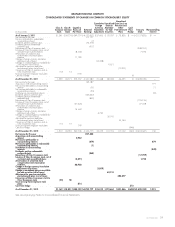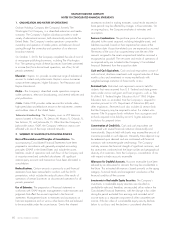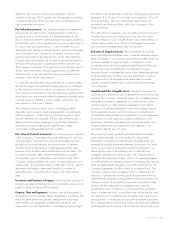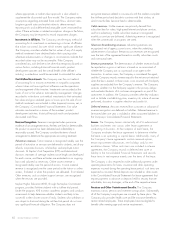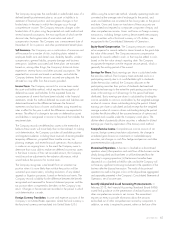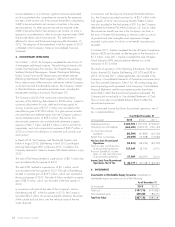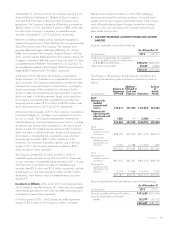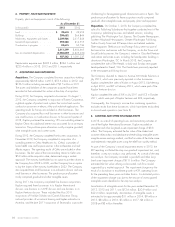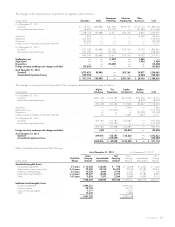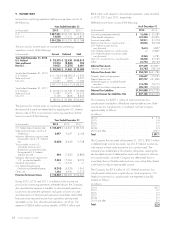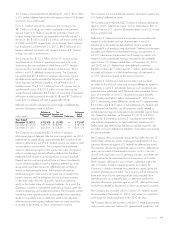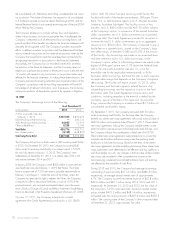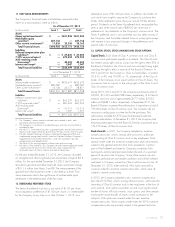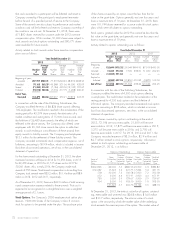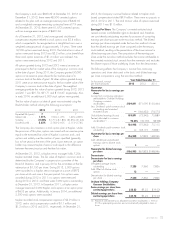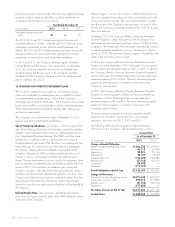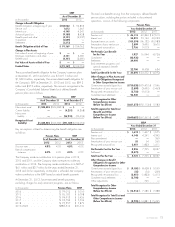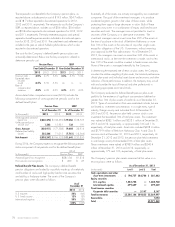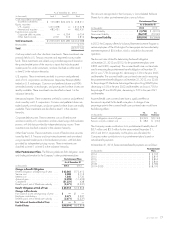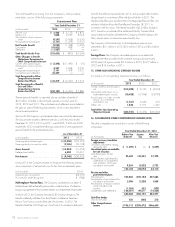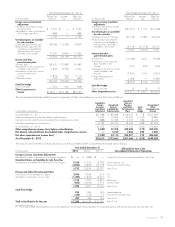Washington Post 2013 Annual Report Download - page 87
Download and view the complete annual report
Please find page 87 of the 2013 Washington Post annual report below. You can navigate through the pages in the report by either clicking on the pages listed below, or by using the keyword search tool below to find specific information within the annual report.
The Company has established at December 31, 2013, $2.6 million
in U.S. Federal deferred tax assets with respect to these U.S. Federal
income tax loss carryforwards.
For U.S. Federal income tax purposes, the Company has
$8.3 million of foreign tax credits available to be credited
against future U.S. Federal income tax liabilities. These U.S.
Federal foreign tax credits are expected to be fully utilized in
the future; $6.8 million and $1.5 million will expire at the end
of 2022 and 2023, respectively, if not utilized. The Company
has established at December 31, 2013, $8.3 million of U.S.
Federal deferred tax assets with respect to these U.S. Federal
foreign tax credit carryforwards.
The Company has $112.1 million of non-U.S. income tax loss
carryforwards, as a result of operating losses and prior stock
acquisitions that are available to offset future non-U.S. taxable
income and has recorded, with respect to these losses, $32.6
million in non-U.S. deferred income tax assets. The Company
has established $31.4 million in valuation allowances against
the deferred tax assets recorded for the portion of non-U.S. tax
losses that may not be fully utilized to reduce future non-U.S.
taxable income. The $112.1 million of non-U.S. income tax loss
carryforwards consist of $101.3 million in losses that may be
carried forward indefinitely; $3.5 million of losses that, if unutilized,
will expire in varying amounts through 2018; and $7.3 million of
losses that, if unutilized, will start to expire after 2018.
Deferred tax valuation allowances and changes in deferred tax
valuation allowances were as follows:
(in thousands)
Balance at
Beginning of
Period
Tax
Expense and
Revaluation Deductions
Balance at
End of
Period
Year Ended
December 31, 2013 ... $ 78,109 $ (5,342) — $ 72,767
December 31, 2012 . . $59,179 $18,930 —$78,109
December 31, 2011 . . $41,359 $17,820 —$59,179
The Company has established $35.6 million in valuation
allowances against deferred state tax assets recognized, net of U.S.
Federal tax. As stated above, approximately $30.0 million of the
valuation allowances, net of U.S. Federal income tax, relate to state
income tax loss carryforwards. The Company has established
valuation allowances against state income tax assets recognized,
without considering potentially offsetting deferred tax liabilities
established with respect to prepaid pension cost and goodwill.
Prepaid pension cost and goodwill have not been considered a
source of future taxable income for realizing deferred tax assets
recognized since these temporary differences are not likely to
reverse in the foreseeable future. The valuation allowances
established against state income tax assets are recorded at the
parent company and the education division and may increase
or decrease within the next 12 months, based on operating
results or the market value of investment holdings. As a result, the
Company is unable to estimate the potential tax impact, given the
uncertain operating and market environment. The Company will be
monitoring future operating results and projected future operating
results on a quarterly basis to determine whether the valuation
allowances provided against deferred state tax assets should be
increased or decreased, as future circumstances warrant.
The Company has not established valuation allowances against any
U.S. Federal deferred tax assets.
The Company has established $37.2 million in valuation allowances
against non-U.S. deferred tax assets, and, as stated above, $31.4
million of the non-U.S. valuation allowances relate to non-U.S. income
tax loss carryforwards.
Deferred U.S. Federal and state income taxes are recorded with
respect to undistributed earnings of investments in non-U.S.
subsidiaries to the extent taxable dividend income would be
recognized if such earnings were distributed. Deferred income taxes
recorded with respect to undistributed earnings of investments in
non-U.S. subsidiaries are recorded net of foreign tax credits with
respect to such undistributed earnings estimated to be creditable
against future U.S. Federal tax liabilities. At December 31, 2013
and 2012, net U.S. Federal and state deferred income tax
liabilities of about $7.7 million and $1.7 million, respectively, were
recorded with respect to undistributed earnings of investments in
non-U.S. subsidiaries based on the year-end position.
Deferred U.S. Federal and state income taxes have not been
recorded for the full book value and tax basis differences related to
investments in non-U.S. subsidiaries because such investments are
expected to be indefinitely held. The book value exceeded the tax
basis of investments in non-U.S. subsidiaries by approximately
$66.8 million and $64.2 million at December 31, 2013 and
2012, respectively; these differences would result in approximately
$5.9 million and $14.7 million of net additional U.S. Federal and
state deferred tax liabilities, net of foreign tax credits related to
undistributed earnings and estimated to be creditable against future
U.S. Federal tax liabilities, at December 31, 2013 and 2012,
respectively. If investments in non-U.S. subsidiaries were held for
sale instead of expected to be held indefinitely, additional U.S.
Federal and state deferred tax liabilities would be required to be
recorded, and such deferred tax liabilities, if recorded, may exceed
the above estimates.
The Company does not currently anticipate that within the next 12
months there will be any events requiring the establishment of any
valuation allowances against U.S. Federal net deferred tax assets.
The valuation allowances established against non-U.S. deferred tax
assets are recorded at the education division, as this is the only
division with significant non-U.S operating activities, and these are
largely related to the education division’s operations in Australia.
These valuation allowances may increase or decrease within the
next 12 months, based on operating results. As a result, the
Company is unable to estimate the potential tax impact, given the
uncertain operating environment. The Company will be monitoring
future education division operating results and projected future
operating results on a quarterly basis to determine whether the
valuation allowances provided against non-U.S. deferred tax assets
should be increased or decreased, as future circumstances warrant.
The Company has recorded a $10.5 million U.S. Federal income
tax receivable at December 31, 2013, with respect to capital loss
and foreign tax credit carrybacks to the 2010 tax year.
The Company files income tax returns with the U.S. Federal government
and in various state, local and non-U.S. governmental jurisdictions, with
2013 FORM 10-K 69


